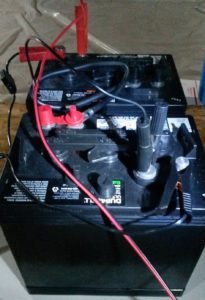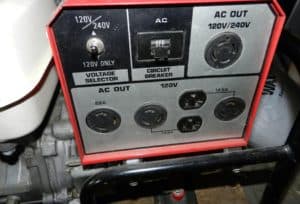When we start thinking of basic preparedness for power outages, one of the big concerns is what to do with your sump pump without electricity.
A heavy deluge of rain and wind can knock out electricity and cause some nasty flooding. If you’re not prepared, your failure to invest several hundred dollars into preparing could cause you thousands in damages along with higher insurance rates.
Just what are the options for a sump pump when the power goes out? As much as I love battery banks to help with power outages, I’m not too proud to step aside and acknowledge a better option its time in the spotlight. In all honesty, though, there are too many variables in everyone’s particular situations.
To pump water out of a basement without electricity, you have 5 primary options:
1. Generator power
2. DIY battery backup with a DC to AC power inverter and deep-cycle battery
3. Dedicated, store-bought battery backup sump pump
4. Water-powered backup sump pump (municipal water households only)
5. Manually remove water
As a general rule when it comes to sump pump contingency plans, I recommend a generator first on the preparedness list.
However, the generator is only part of a system-wide plan to address the problem. Following on the list is a battery-backup (homemade or store-bought) to work in conjunction with your existing sump pump — but only when you have your other bases covered.
I’ll discuss why I believe a generator beats a battery backup system in most cases, a few other alternatives that might just be right for you, and some things you can do to mitigate and prevent basement flooding. Let’s roll up our pant legs and jump right in!
Why Does a Generator Win over a Battery Backup System?
Battery Backup Systems
There’s no denying that some deep cycle marine batteries or GC2 golf cart batteries will run a sump pump. The problem is in the fact that a sump pump draws a large amount of energy in short spurts over a long period of time. Depending on how often your sump pump needs to kick on to pump out the rising water, you might get anywhere from 5-12 hours on most battery setups for high-frequency pumping.
I have an entire article here with multiple types of batteries and various ratings for sump pump watts so you can get an idea of just how long you could power a sump pump from a deep cycle battery.
If your pump only kicks on once every 15 or 30 minutes, you might get days out of the battery backup system. Regardless, once the battery is done, it’s done – at least until you find a means to charge it back up.

Cost is also another factor. If you were to buy a designed battery back-up sump pump from a manufacturer, you’re looking to pay in the $300 – $700 range. If you were to build your own system from scratch, you’d ideally be looking at 2 GC2 golf cart batteries or 2 deep cycle marine batteries.
You’d also need a dedicated charger and maintainer for them as well as a high wattage DC to AC power inverter. You’re already looking at a minimum of $450.
However, what a battery backup sump pump has going for it though is that if you happen to be a few hours from home when the storm hits, as long as you’ve maintained and cared for those batteries, you should find that they are taking care of your basement until you get back.
This would ideal for those of you who live in areas not prone to power outages or who typically only lose power for a half an hour or so. But there’s this guy named Murphy that everyone is always talking about…
Portable Generators
For the same price as it costs to build a battery backup system, you could get a small to medium portable generator. You would have far fewer limitations and far more energy output and duration.
This generator could power your sump pump, basic electronics/lighting in the home, and recharge a battery bank that you have set aside for basic home lighting and device charging. As long as you have a couple 5-gallon jugs of treated gasoline, you’ll be set to go for days and days without power.
The major drawback of relying on only a portable generator is if you are not home when the storm knocks your power out. The generator is not going to hook itself up and run downstairs to plug itself in for you.

Whole Home Generators
If you have the means, the strongest course of action you could take would be to have a whole home generator, like those provided by Generac.
When the storm hits and the lights decide to go out, this generator will kick on automatically and start powering all of the elements of your home that you designated it to.
No worries while you’re visiting family out of state or taking what is supposed to be a relaxing vacation! The only practical thing that could go wrong for you, in this case, would be that the sump pump itself gave up the ghost with no fault to the generator.
Water-Powered Backup Sump Pumps
This option is definitely a viable one for those of you who are hooked up to municipal water. They come in either “above sump” or “in sump” designs.
The water powered backup sump pumps can work without power as long as you still have municipal water pressure. They use the incoming municipal water pressure to create a siphon in order to pump the water out of the basement.
For every two gallons you pump out, you’ll use one gallon of municipal water (that you, of course, will pay for – but it sure beats a flooded basement!).
Some drawbacks for this type of system are that some municipalities ban the use of these sump pumps due to water shortages during power outages and emergencies.
Some municipalities who allow them also require that these be professionally installed and inspected on a yearly basis. They also require a new water line to be brought down, a backflow preventer to be installed, and a new drain line to be put in as well.
Though some aspects of a water powered sump pump might be tedious, this might actually be the best option for some of you. It’s definitely worth the research if you are on municipal water.
How to Mitigate and Prevent Basement Flooding
A lot of little things can be done ahead of time to help us out when the big storm happens.
The first would be to have at least one extra sump pump to replace your primary sump pump in case it dies on you. Be sure to have anything that you’ll need handy or done ahead of time (PVC piping, check valves, pipe primer, cement, rubber couplers, etc) so that if you need to change it in an emergency that it will go as quickly as possible.
There are plenty of youtube videos on how to replace them in as little as 10 minutes.
To take this a step further, if you have the room in your pit you could always have a primary pump and a battery backup pump. Check out sump pumps that have a vertical rod that guides the float so there is less chance of it getting hung up on something.
Another thing is to purchase are some Flexdrain Downspout Extensions to discharge the water flooding down your roof as far away from the house as possible. Remember to point them as downhill as possible! You can always just put these out during a storm and bring them back into the garage when the storm has passed.
Of course, having some pails, buckets, and old towels always near sump is always a good idea for manual removal and cleanup of water.
To Sump it all Up…
A battery backup sump pump certainly has its place and has an advantage at times. However, I’m of the opinion that it serves best as something to compliment your existing system after you’ve done a few things first.
I recommend that you will have acquired and learned how to use a generator. Be sure to test it on the sump pump before you need to do it in a blackout.
After that’s happened, make sure that you’ve got a means to divert water away from your house as it runs down your roof and the drain spouts.
Make sure that you’ve got a spare sump pump and the tools, materials, and knowledge to swap out the existing pump if it goes bad.
I would even recommend having a battery bank in place for your lighting and charging needs first as well.
You could always move it to be a designated battery backup system for the sump pump as well if you really needed to and if you had a large enough inverter.
Only then would I consider looking into a battery backup sump pump for my emergency preparations.
That, of course, is just my opinion and everyone’s basement and geography are different, so your mileage may vary. Either way, I hope that you and your family get through all of life’s future downpours dry and with the lights on!

